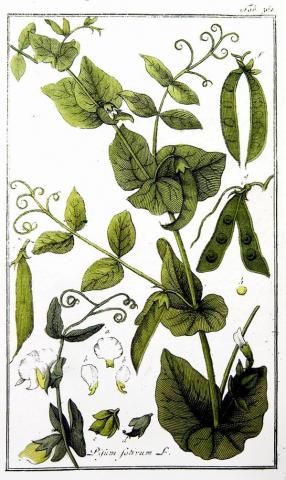Pisum sativum

| Common Name | Pea
|
|---|---|
| Genus | Pisum
|
| Species | sativum
|
| Ploidy | Diploid
|
| Chromosome Number | 2n=14
|
| Genome Size | ~4.3 Gbp
|
| Taxonomy | cellular organisms; Eukaryota; Viridiplantae; Streptophyta; Streptophytina; Embryophyta; Tracheophyta; Euphyllophyta; Spermatophyta; Magnoliophyta; Mesangiospermae; eudicotyledons; Gunneridae; Pentapetalae; rosids; fabids; Fabales; Fabaceae; Papilionoideae; Fabeae; Pisum
|
Pea (Pisum sativum L.) is one of the first domesticated crops, and was the model crop for the foundational genetic studies by Gregor Mendel, which he first reported in 1865. Pea is grown in most temperate regions of the world with annual production over the past decade of 10-12 million tonnes of field pea and 14-17 million tonnes of vegetable pea. Pea belongs to the Leguminosae family and consists of two species, P. fulvum and P. sativum with several ‘wild’ subspecies of P. sativum. Canada is the leading producer and exporter of field pea in the world. Saskatchewan is the leading province in pea production followed by Alberta and Manitoba.
Pea is a rich source of protein, slowly digestible starch, fiber, vitamins and minerals at a modest price. Whole pea, pea flour, and pea fractions (protein, starch, fiber) are becoming widely used in many food products, and specialty aquaculture and pet food applications.
Most pea breeding activities in the world are conducted in public institutions in Canada, USA, Australia, Europe, India and China, with smaller programs in Africa and South America. A few private companies breeding pea are based in Europe, USA and New Zealand. Through breeding and agronomic improvements, field pea yields have increased by approximately 2% per year over the past 15 years. Lodging resistance has been improved through selection for the semileafless trait and stem stiffness. Internationally, key efforts are underway to address disease resistance (particularly fungal), abiotic stress resistance, and seed quality through conventional and molecular breeding approaches.
-
 Tom D. Warkentin: Breeding field pea varieties and conducting related research in collaboration with colleagues in areas including disease resistance, abiotic stress resistance, and nutritional quality.
Tom D. Warkentin: Breeding field pea varieties and conducting related research in collaboration with colleagues in areas including disease resistance, abiotic stress resistance, and nutritional quality.
